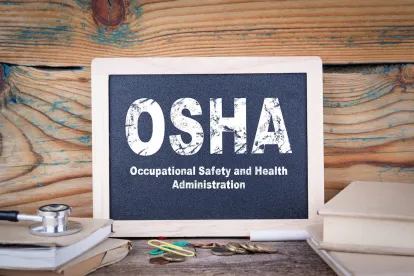In response to the modified COVID-19 recommendations published by the Centers for Disease Control and Prevention (CDC) on July 27, 2021, on Friday, August 13, 2021, the Occupational Safety and Health Administration (OSHA) updated its Guidance on Mitigating and Preventing the Spread of COVID-19 in the Workplace.
Mask Wearing by Vaccinated Individuals
As anticipated, OSHA, in light of the increased risk posed by the Delta variant, joined the CDC in calling for vaccinated (in addition to unvaccinated) individuals to wear masks in “public indoor settings,” in areas of substantial or high transmission. While OSHA references the CDC language in its own revised guidance, the agency also recommends as follows:
“Fully vaccinated people in areas of substantial or high transmission should be required to wear face coverings inside … as well.”
While this reference to wearing face coverings “inside” creates some ambiguity as to OSHA’s intentions, presumably, OSHA is not calling for mask wearing in every “indoor” area. For example, given prior CDC and OSHA guidance, it is likely that OSHA does not expect an individual to wear a mask when alone in the employee’s private office.
A common sense reading of the revised OSHA document indicates that the agency is advising, for worksites located within a “substantial or high transmission area,” that masks be worn by all in communal areas – likely including, for example, elevators, break rooms, restrooms, hallways, and lobbies. With regard to physical distancing for unvaccinated individuals, the revised OSHA guidance specifically extends its physical distancing recommendation for unvaccinated workers to all “communal areas.” It is logical that OSHA’s call for mask wearing by both vaccinated and unvaccinated workers extends to, at least, communal areas of the workplace as well.
One likely question employers may have is whether individuals in a meeting room need to wear masks when all are fully vaccinated. Although OSHA’s position is not clear – a relatively literal reading of the word “inside” might suggest that the agency intends to include all rooms where multiple individuals are present. Further, while the guidance is “designed to help employers protect workers who are unvaccinated (including people who are not fully vaccinated) or otherwise at-risk,” the updated language specifically notes the added intention of helping employers and workers in areas of substantial or high community transmission to “take appropriate steps to prevent exposure and infection regardless of vaccination status.”
Stronger Message on Vaccination and Testing
Importantly, in its revised guidance, OSHA states:
“OSHA suggests that employers consider adopting policies that require workers to get vaccinated or to undergo regular COVID-19 testing – in addition to mask wearing and physical distancing – if they remain unvaccinated.”
Along with more strongly recommending vaccination, OSHA plainly is suggesting that employers that do not mandate vaccination at least require that unvaccinated employees be subject to “regular [COVID-19] testing.”
While the OSHA guidance does not define “regular,” it is notable that the Biden Administration is requiring unvaccinated federal workers to undergo weekly COVID-19 testing.
Proper Response to Employee’s COVID Infection or Close Contact
Consistent with CDC guidance, OSHA also recommends removal from the workplace of: “all infected people, all people experiencing COVID symptoms, and any people who are not fully vaccinated who have had close contact with someone with COVID-19 and have not tested negative for COVID-19 immediately if symptoms develop and again at least 5 days after the contact (in which case they may return 7 days after contact).”
With regard to vaccinated workers who had close contact with an individual with COVID-19, OSHA recommends that the individual “get tested for COVID-19 3-5 days after exposure and be required to wear face coverings for 14 days after their contact unless they test negative for COVID-19.”
Of course, one example of a variety of uncertainties associated with this revised guidance is how the 14-day mask wearing provision for exposed vaccinated employees relates to the apparent expectation by OSHA that vaccinated and unvaccinated employees will wear a mask generally inside regardless – at least in areas of substantial or high transmission. What this question highlights is that the revised guidance lacks clarity in a variety of respects.
Notably, the OSHA guidance also has specific and rigorous recommendations for COVID-19 infection control measures in “meat, poultry, and seafood processing settings; manufacturing facilities; and assembly line operations.” The specific measures recommended for those high-risk workplaces are detailed in OSHA’s written guidance document.
Of course, healthcare settings are not covered by this general guidance document, but rather are regulated by the Emergency Temporary Standard issued on July 27, 2021, providing mandatory COVID-19 infection control rules for hospitals and various other healthcare employers.
Practical Significance of OSHA Guidance
Although OSHA disclaims that its recommendations are legally binding on employers, the agency also includes language that signals that failure to adhere to the recommendations could be legally significant for the employer. Specifically, OSHA prefaces its guidance by stating:
“The recommendations are advisory in nature and informational in content and are intended to assist employers in providing a safe and healthful workplace free from recognized hazards that are causing or likely to cause death or serious physical harm.”
Given the fact that the General Duty Clause of the Occupational Safety and Health Act provides that an employer shall provide “employment and a place of employment which are free from recognized hazards that are causing or are likely to cause death or serious physical harm to his employees,” OSHA may be messaging that failure to adhere to its recommendations could be evidence of noncompliance with the General Duty Clause.





 />i
/>i

